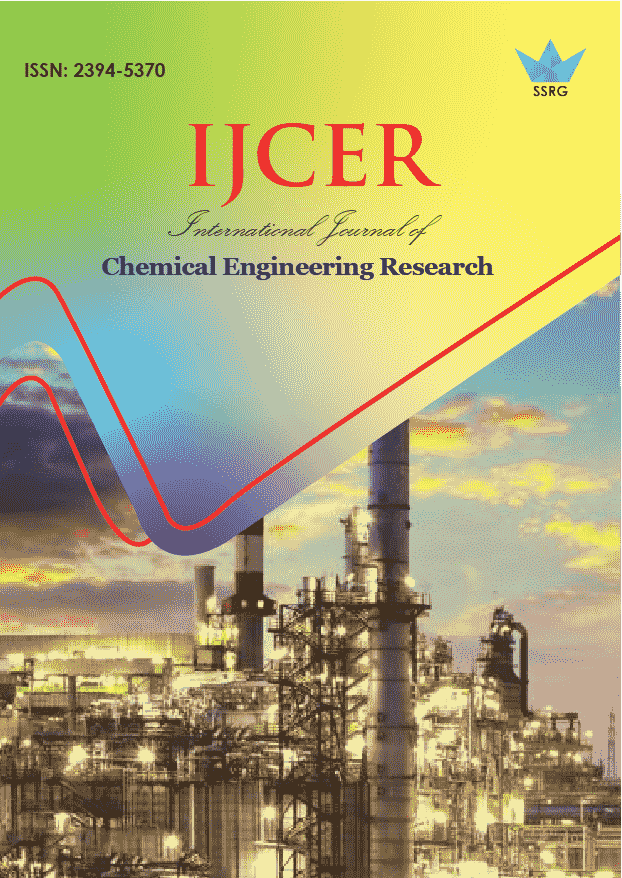Preparation of Powdered Egg Yolk

| International Journal of Chemical Engineering Research |
| © 2015 by SSRG - IJCER Journal |
| Volume 2 Issue 3 |
| Year of Publication : 2015 |
| Authors : Prasanna Joshi, NavinChoukade, Amol Patil, Madhuri Jadhav, A.S.Jadhav |
How to Cite?
Prasanna Joshi, NavinChoukade, Amol Patil, Madhuri Jadhav, A.S.Jadhav, "Preparation of Powdered Egg Yolk," SSRG International Journal of Chemical Engineering Research, vol. 2, no. 3, pp. 12-14, 2015. Crossref, https://doi.org/10.14445/23945370/IJCER-V2I2P103
Abstract:
Egg is an excellent source of high quality of protein of which is yolk contains 44% and egg contains 56%.The dried egg powder can be stored and transported without refrigeration at room temperature. The product is quite stable and contains enough shelf life. This product can replace the use of fresh egg and also in bakery product (cakes, ice-creams, cookies, doughnuts and sauces, etc).
Keywords:
SHEETAL LABORATARIES, PUNE
References:
[1] BÜCHI. Spray Drying. Mini Spray dryer B-290. Technical Data B-290. Disponívelem http://www.buchi.com. Acessoem: 23 set. 2006
[2] CABONI, M. F. et al. Effect of processing and storage on the chemical quality markers of spray-dried whole egg. Food Chemistry, v. 92, n. 2, p. 293–303, 2005.
[3] DEMAN, J. M. Principles of Food Chemistry. 3.ed.Gaithersburg: Aspen Publishers, 1999. 520 p. (A Chapman & Hall food science book).
[4] DEPREE, J. A.; SAVAGE, G. P. Physical and flavour stability of mayonnaise. Trends in Food Science and Technol., Amsterdam, v. 12, n. 5-6, p. 157-163, 2001.
[5] GUARDIOLA, F. et al.Oxysterol formation in egg powder and relationship with other quality parameters. J. Agric. Food Chem, Columbus, n. 43, p. 1903-1907, 1995.
[6] Burley, R.W., and D.V. Vadehra, 1989. The avian egg chemistry and biology.
[7] Coleman, M., 1998. Chicken immunology and egg antibodies: laying hens, antibody - factory, IGY-technology, biomedical applications and treat disease. The 2ndInternational Symposium on Egg Nutrition and Newly Emerging Ovo Technologies Banff Ontario Canada April 5 to 8, 1998.
[8] In Egg Uses and Processing Technologies - New Developments. Edited by J.S. Sim and S. Nakai. CAB International, Wallingford, U.K.
[9] Froning, G.W., and D. Bergquist, 1990. Utilization of inedible egg shells and technical albumen using extrusion technology. Poultry Sci. 69:205 l-2052
[10] Germadios, A., C.L. Weller, M.A. Hanna, and G.W. Froning, 1996. Mechanical and barrier properties of egg albumen films. J. of Food Sci. 61:585-589.
[11] Johnson, E.A., 1994. Egg white lysozyme as a preservative for use in foods. In Egg Uses and Processing Technologies - New Developments. Edited by J.S. Sim and S.Nakai. CAB International, Wallingford, U.K.
[12] Li-Chan, E.C.Y., W.D. Powrie, and S. Nakai, 1995. The chemistry of eggs and egg products. In Egg Science and Technology.Edited by W.J. Stadelman and O.J.
[13] Cotterill. The Haworth Press Inc. New York.
Lu, C.L., and R.C. Baker, 1986. Characteristic of egg yolk phosvitin as an antioxidant for inhibiting metal-catalyzed phospholipid oxidation. Poultry Sci. 65:2065-2070.
[14] MacNeil, J., 1997. Separation and utilization of waste egg shell. International Egg Commission Annual Production and Marketing Conference. Toronto, Ontario.September, 1997.
[15] Keey, R.B. 1972. Drying Principles and Practice. Pergamon Press, London.
[16] Likov, A. 1968. Drying Theory, Moscow.
[17] Lin, Q., F. W. Bakker-Arkema. 1999. Capacity estimation of High Temperature Grain Dryers- a Simplified Correlation Method.Agricultural Engineering International: the CIGR Ejournal Vol. I. 1-17.
[18] Sun, Da-Wen. 1999. Comparison and Selection of EMC / ERH Isotherm Equations for Drying and Storage of Grain and Oil Seeds. Agricultural Engineering International: the CIGR EjournalVol. I. 1-9.
[19] Tolmac, D., M. Lambic. 1997. Heat transfer through rotating roll of contact dryer. International Journal, Heat and Mass Transfer, Vol. 24.569-573.
[20] Tolmac, D. 1997. Contribution theory and drying practice. University in Novi Sad, Technical faculty “Mihajlo Pupin”, Zrenjanin.
[21] Webb, R.L. 1994. Principles of Enhanced Heat Transfer. John Wiley, New York.

 10.14445/23945370/IJCER-V2I2P103
10.14445/23945370/IJCER-V2I2P103